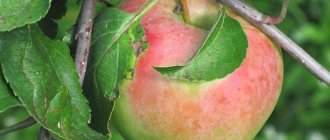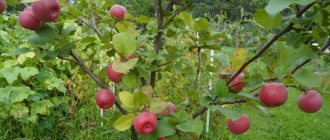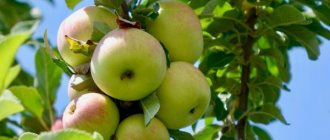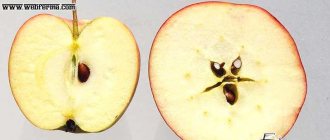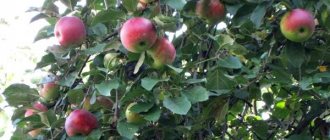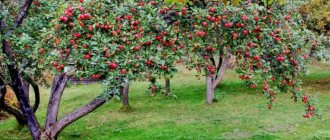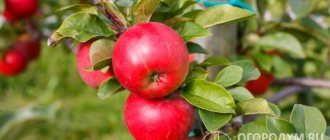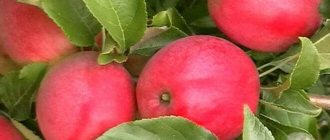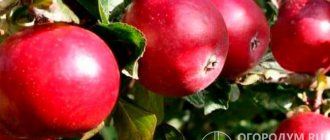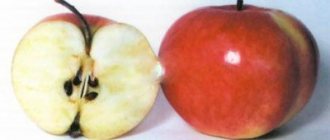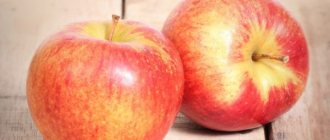The Northern Sinap apple tree is a late-winter variety of apple tree. She was bred by I.S. Isaev at the experimental station of young naturalists through sequential seed reproduction of the Kandil-Kitayka variety.
The progenitor of Northern Sinap is Crimean Sinap (Kandil Sinap). Its fruits are tasty and valued at the royal court, but the tree itself was grown only in the southern latitudes of the country. Having wished to have this variety in his gardens, I.V. Michurin pollinated the Kitayka apple tree with pollen of this variety and obtained the Kandil Kitayka variety. The new variety adopted the wonderful taste of the Crimean sinap, but increased its frost-resistant properties slightly.
At the second stage of selection in 1927, the seeds of Qandil Kitai were planted in the Moscow region, at the experimental station of young naturalists. The process was led by I.S. Isaev. Some of the seedlings could not tolerate the climate of the Central region, and among the survivors, the strongest and most promising seedling was chosen, with stable fruiting and tasty fruits. He became the first apple tree of the Northern Sinap variety , a description and photo of which is presented in this article.
Apple tree Northern Sinap
This variety is recommended for cultivation in regions with a moderately cold climate : the Central Black Earth Region, the lower and middle Volga region. A special form of the tree, slate, can grow in Eastern Siberia.
Advantages of the variety:
- Good keeping quality of fruits;
- Dessert taste of apples;
- High winter hardiness;
- Rapid entry into fruiting.
Flaws:
- Large tree size on a full-grown scion;
- Fruits of uneven size.
Diseases and pests
Black cancer
| |
codling moth
|
Characteristic
Tree
Vigorous, powerful, with a wide pyramidal sparse crown. The trunk and skeletal branches are gray-brown. The predominant part of the wood is perennial lateral branches from 3-5 skeletal branches.
The height of the tree , grafted onto a vigorous rootstock, reaches 7 meters , and the width is 6-7 m in diameter. Semi-dwarf rootstocks form a more compact plant crown.
Northern synapse on a vigorous rootstock.
Escapes
Straight, medium thickness with slight angulation, classic brown color . Cherevichki are small and few in number.
Leaves
Shiny, medium size, wide and heavily pubescent . Their color is dark green, with a slightly grayish tint.
Flowers
Large, with red buds and pink petals.
Fruits and tasting assessment
Medium size ( 110-130 g ), round-conical shape. The outer color of the apple is green, with a brown-red blush. Subcutaneous dots are light and numerous. The pulp is white with a light mint tint, juicy and sweet, with a pleasant sourness. It has medium density and fine-grained structure.
The tasting score is quite high - 4.3-4.4 points.
Fruits of the Northern Synap.
Watch the video review of the fruits of the Northern Synap:
Productivity
Tall, reaches 150 kg from an adult tree.
Winter hardiness
High (up to – 35°Ϲ), only slightly inferior to Antonovka Ordinary.
Disease resistance
Average.
Self-fertility
This variety is a partially self-fertile variety, but without cross-pollination by other apple trees it produces less than half the possible yield. To increase fertility, it needs apple pollinators, such as:
- Antonovka;
- Slav;
- Pepin Saffron.
Antonovka.
Slav.
Pepin Saffron.
Advice! If you do not have space to plant a pollinator variety, you can graft a branch of it onto an already growing apple tree.
Description
To understand whether this fruit variety is suitable for your garden, you need to know what basic characteristics it has.
Advantages and disadvantages
Due to the fact that the tree is unpretentious in caring for, it has many advantages that significantly outweigh the disadvantages.
The variety is quite winter-hardy, not counting individual subspecies. Crimean and Northern - are not resistant to cold and require higher temperatures, so they bear more fruit in warm periods, for example, in autumn. Despite this, if these apple trees are properly protected, they will produce a harvest in Siberia.
The crop is characterized by high productivity and sufficient early fruiting. From one mature tree you can harvest 100 kg of apples. They have an unforgettable sweet taste with a subtle hint of sourness. The advantages include resistance to scab, although you still have to treat the plant trunk and crown.
The peculiarity of the variety is that it is easily transported and can be stored for 7-9 months. The fruits are used for drying, making compotes, baking and eaten fresh.
The disadvantages of the variety include:
- the trees are too large and therefore not suitable for growing several in private areas;
- yield depends on weather conditions. The less cold the plant endures, the more apples will be harvested later;
- with poor care and a large number of ovaries on the tree, the yield will fall and the quality of the fruit will deteriorate significantly. For apples to be truly tasty and juicy, they must be fully ripe. Unripe fruits are bitter and difficult to store;
- the variety does not like drought and reacts specifically to dew;
- if the seedling does not have enough fertilizer, the fruits are then affected by bitter pitting.
Characteristics of the tree and fruits
All trees grow to massive sizes. This fact must be taken into account when planting in order to allocate enough territory to the seedling so that it can take root, grow, receive the right amount of heat, lighting and bear fruit well.
The tree grows low, about 5 m, and the dwarf subspecies is no more than 3 m. The branches of the tree are sparse, so the crown is not dense, which significantly affects the harvest.
The shoots of the plant are not thick, they droop, and the leaves on them are located quite sparsely. They are green or dark green. Their shape is not completely round, the edge is slightly raised upward, but the leaf faces down. It is impossible to say anything specific about the type of fruiting, because this apple tree is mixed and different every time.
The fruits of the Sinapa variety are small in size. The weight of one apple is 120-150 g. The color of young fruits is yellow with a green tint; when stored for a long time, they acquire a golden hue.
An exceptional feature of this variety is that the side that was exposed to the sun takes on a reddish tint, like a blush. The peel is dense, rough, but easy to peel. If you store the fruit for a long time, an oily coating will accumulate on it.
Apples contain a moderate amount of sugar - 9.7%, and when ripened, the acidity and sweetness become almost equal. The pulp is white, tender and juicy.
Taste
In terms of taste characteristics, Sinap apples are quite popular. Their pulp is fine-grained, loose and juicy. It has a wonderful taste, thanks to the harmony of sweet and sour notes, as well as a wonderful and rich aroma.
Productivity
Very prolific apple variety
The variety is generous in yield, but very picky. From one mature apple tree you can harvest up to 170 kg of apples per year, and from more mature representatives - 2-3 quintals. However, such a high yield is rare because the apple tree bears fruit only once every 2-3 years.
For apples to be tasty, after picking you need to let them sit for 3-4 weeks, because only then will they ripen. The fruits of the tree become fully ripe after the end of the warm summer period - at the end of August or beginning of September.
Pollinators
An apple tree cannot bear fruit on its own; to do this, 1-2 other types of apple trees are planted next to it. For Sinap, Sinap Sarah, White Rosemary and Renet Orleans are suitable. With the help of such tree varieties, this species will be able to produce good harvests.
Winter hardiness
The apple tree, which is of Crimean origin, cannot have high winter hardiness. In this variety it is characterized as medium. The tree can withstand short-term changes in cold temperature, up to a maximum of -28 °C without damage.
Some subspecies, such as Crimean and Northern, do not like winter. At temperatures lower than -28°C, trees begin to freeze, the root system suffers, so due to improper care and planting, the plant may die.
Disease resistance
The variety has average resistance to both cold weather and various diseases. It copes with scab and powdery mildew, but not with other diseases and pests. To do this, the tree needs to be looked after, and when dry branches and rotten fruits appear, they need to be plucked so that the rest of the tree is not affected.
Place of cultivation
These varieties are grown in large, warm and sunny areas. Since they do not like the cold, they are often planted in gardens in the Crimea. Some subspecies were bred specifically so that the plant could bear fruit in the Urals and Siberia, so the territory and region where the future fruit tree will grow is chosen depending on its resistance to cold.
Reviews
Sergey N., Ryazan. ‟ Northern Sinap is already a classic of winter apple trees. I have 2 of these, I bought them when I looked at the photo and description of the variety. But we’ll eat our apples until next summer! The variety is unpretentious, but so that it does not cover other trees with its shadow, I prune it every year. ”
Tamara Leonidovna T., Ivanovo. ‟ I inherited this apple tree as an adult from the previous owners of the dacha. I don’t know how old it is, but it bears fruit every year. This didn’t suit me, and I cut off about a quarter of its branches. The apple tree revived and began to bear fruit every year. In general, it quickly regained its previous size, growing half a meter of shoots per year.”
Ivan Sergeevich N., Volgograd. ‟ Sinap is certainly good, but it is morally outdated. Its main advantage is the long-term storage of apples, but otherwise it is an ordinary tree. I don’t like the fact that the apples become smaller if there are a lot of them on the tree, and that the apples are tasteless immediately after picking. To become pleasant, they need to lie down for at least 2 weeks.”
Gallia, Kazan. ‟ I planted this apple tree 4 years ago.
The tree took root well and grew quickly! On the advice of the seller, I chose a seedling on a low rootstock, and it bloomed 2 years after planting. And the next year we collected 8 apples from it!”
Care
The productivity of the variety depends on the correct formation of the crown. The next year after planting, cut off all dried branches.
Form a crown in the spring. Cut the central trunk of a young tree by 40 cm; shorten it slightly for an adult one. Shorten the skeletal branches by a third. Form a powerful crown of side branches. Remove those growing inward and dry.
In the first year after planting, the apple tree does not need to be fed. You have put enough fertilizer in the hole. Then feed according to the following scheme:
- in early spring, when digging;
- when the buds are swollen;
- before and after flowering;
- before winter comes.
In spring, use organic fertilizers at the rate of 500 g per trunk. When the buds are swollen, sprinkle urea around the perimeter of the trunk. The amount of fertilizer does not change. We fertilize again when the ovary forms on the trees.
We use a solution of 1 bucket of compost, 50 g of potassium chloride, 140 g of superphosphate, 30 g of nitroammophosphate. When the apple tree has bloomed, feed it with 500 g of bird droppings diluted in a bucket of water. In autumn it is better to use superphosphate. You need to dissolve 30 g of the substance in 1 liter of water.
Regularly feed the variety with potassium salts throughout the season with a break of half a month. Liming is carried out once every 4 years. For 1 square meter of area, 150 g of the substance is enough. In winter, mulch the soil with a layer of peat or rotted manure. This will help prevent it from freezing. Spruce branches will help repel rodents.
Watering is necessary depending on the age of the crop. For young seedlings up to 1 year old, the norm is 2-3 buckets of water per 1 square meter. Mature plants need about 60-100 liters per square meter. Wet soil needs to be loosened and weeds removed. We would like to recommend an article on how to care for an apple tree month by month.
The Northern Sinap apple variety is quite resistant to diseases and pests, but preventive procedures will not hurt. For pests, spray Northern Sinap with wormwood and preparations containing calcium. Bordeaux mixture or Fitosporin will help against diseases. By winter, treat with copper sulfate.
Landing
Deadlines
Young apple trees are planted in spring or autumn . Autumn planting ( from mid-September until the onset of persistent frosts ) is considered more correct.
It is better to plant apple trees in the fall.
Planting a plant in the spring is useful for seedlings grown in latitudes more southern than the future growing location, and for trees under two years of age . It is produced from mid-April to mid-May.
Technology
Choose a well-lit and spacious place , 3.5-4 meters away from other trees.
Attention! Apple trees do not like proximity to high groundwater! If your site “floods” during spring floods, plant trees on higher ground.
5 stages of proper tree planting:
- Soak the roots of the tree for 5-10 hours in clean water;
- Prepare the planting hole. For planting a 2-3 year old apple tree, a depth and width of 60-70 cm is sufficient;
- Drive a strong peg into the bottom, at least 1.5 meters in length;
- Spread the roots of the seedling in the hole so that they look in different directions;
- Fill the hole with soil and tie the tree trunk to a peg in 2 places.
Growing and agricultural technology
The Sinap apple tree variety does not require special agricultural technology and care , but, like any tree, it needs watering, pruning and protection from pests.
Northern synapse has average drought resistance and does not require abundant watering. If you do not prune a mature tree, its fruits will become small and less juicy.
Pruning and crown formation
Crown formation is necessary for young seedlings aged 2-7 years. With it, the length of the shoots is shortened, which allows the tree to grow in the form chosen by the gardener:
- Discharged-tiered;
- Cup-shaped;
- Vertical palmette.
Vertical palmette.
Important! Pruning shoots makes the tree branch! If you do not do this, the tree will not be able to form the correct trunk!
Tree pruning is necessary for hygienic purposes and to remove excess green mass from mature apple trees. During hygienic pruning, branches that thicken the crown, broken shoots and disease-affected shoots are removed.
Winter-hardy varieties of apple trees for the Moscow region and other regions: “Antey”
Winter-hardy varieties of apple trees
An excellent species for temperate climates and winter seasons with sudden temperature changes. Fruiting shrubs most often grow to normal height; the crown has the shape of a regular pyramid or is slightly round. The apples are quite large, in the shape of a circle or cone. From the very beginning, the fruits are greenish in color, then acquire a reddish color that looks like blush. The pulp is green, filled with juice, the smell is tart and pronounced. This type of apple is commercial, and the costs for cultivating these fruit-bearing trees are quite small. The fruits have excellent keeping quality, long storage time and excellent presentation.
Typically, the process of bearing a harvest begins when the fruit-bearing tree reaches two to three years of age. Most often, the weight of one apple is approximately two hundred to two hundred and fifty grams. Typically, experienced gardeners and summer residents begin collecting fruits at the end of the first autumn month - at the beginning of the second autumn month. The fruit maintenance period is approximately five to six months.
Ripening and fruiting
Precociousness
The Northern Sinap apple tree is an intensive variety that quickly begins to bear fruit. A tall tree produces a harvest of more than 3 kg, starting from 5-6 years of age.
Dwarf trees bloom in the second year after planting. With excessive nitrogen fertilizing, the start of fruiting is delayed, and the tree itself actively increases its green mass.
Deadlines
Maturation
The fruits of this variety reach removable ripeness from the beginning of October to its middle. Apples hanging on a branch are not afraid of temperatures dropping to 0 °Ϲ, and the riper the fruit, the better its taste. Apples picked unripe will wither faster during storage and have a more sour taste.
For truly good taste, Northern Sinap apples need a sum of active temperatures of at least 2500-2700 °Ϲ.
Harvest storage
When collected in time, the fruits are stored until the beginning of June. The optimal storage temperature for the crop is 0-4 °Ϲ. At higher temperatures, the harvest is stored until March-April.
Fruits of the Northern Sinap, prepared for storage.
Advantages and disadvantages
Over the long period of existence of the Northern Synapse, gardeners have accumulated vast experience in working with it. The positive and negative properties of these apple trees have long been known, and they should definitely be taken into account when choosing a variety for planting on a personal plot.
The Northern Sinap apple harvest can be stored almost until the middle of next year
Pros:
- Frost resistance and drought resistance.
- High yield.
- Precociousness.
- Phenomenal keeping quality and good transportability of the crop.
- Excellent taste.
- The ability to use the crop both for storage and for industrial processing.
- Apples don't fall off for a long time.
Minuses:
- Large dimensions of a tree grafted onto a tall rootstock.
- Average resistance to diseases.
- With a high harvest there are many small fruits.
- Very late ripeness.
- When grown north of the recommended regions, apples do not have time to gain sugar content.
- Partially self-fertile, requires pollinators for a good harvest.
- Requires regular pruning and maintenance.
- Good taste appears only after long-term aging of picked apples.
- Sharp frequency of fruiting.
Features of the tree depending on the rootstock
The rootstock onto which the cultivated seedling is grafted determines not only the size of the future tree, but also early fruiting, the lifespan of the tree and the size of the apple.
Vigorous
They produce the tallest tree, up to 7.5 m in height. Such apple trees are the most unpretentious , they live up to 60 years, but they begin to bear fruit only 6-7 years after planting. Apples grown on a full-grown tree are smaller, about 80-100 grams, and uneven in size.
Semi-dwarf
The best option for growing. Such a seedling will not grow higher than 4.5-5 m in height and will begin to bear fruit in the third year after planting. The semi-dwarf fruits are larger (110-130 g) and have a more pleasant taste.
Northern synapse on a semi-dwarf rootstock.
Dwarf
Blooms in the second year after planting. This miniature tree, 2.5-3 m in height, bears large (120-140 g) fruits, but lives only 25-30 years . The best dwarf rootstock of Northern Sinap is considered to be No. 62-396.
In the video below you can see what Northern Sinap looks like on a dwarf rootstock:
Attention! Dwarf apple trees have a shallow root system. They tolerate high groundwater levels better. It is important not to loosen their tree trunk deeply and tie the young tree to 3 pegs at once!
Advantages and disadvantages
Advantages of all types of Synap:
- precociousness;
- excellent taste;
- high-quality and large harvest;
- good winter hardiness;
- long (6-7 months) shelf life;
- versatility of use;
- excellent transportability.
The disadvantages include:
- large growth and spreading of trees;
- low resistance to scab and powdery mildew;
- significant deterioration in fruit quality without crop standardization;
- low drought resistance;
- sharply periodic yield.
The large dimensions of the trees lead to the need to plant them at a distance of 5-6 m from each other. This places restrictions on the total number of apple trees in a small garden. In the dwarf version, the distance between trees can be reduced to 2 m.
Other varieties of Sinap
Orlovsky
Severny's closest relative. It is also winter-hardy and moderately resistant to disease.
Differences between the Oryol Sinap and the Northern:
- Larger fruits (140-170 g);
- Ripening 1-2 weeks earlier than Northern;
- Sensitivity to calcium levels in the soil;
- Less sugar content in apple pulp;
- Lack of frequency of fruiting in adulthood.
Orlovsky Sinap.
Qandil
Refers to heat-loving apple trees . The main value of the variety is productivity, keeping quality and excellent taste of the fruit . Disadvantages are the “capriciousness” of the tree, late entry into fruiting and the frequency of harvests even in young plants.
Sinap kandil.
Belorussian
Less popular due to the mediocre taste of apples and their low juiciness.
Belarusian synap.
Mountain
Refers to new varieties. It was included in the State Register for the North-West region in 2009. It is characterized by fast growth, good taste, large fruit size, and winter hardiness.
Mountain synapse.
Watch the video review of the Mountain Synap:
Minusinsky
Recommended for cultivation in the East Siberian region . The tree produces small apples weighing about 40 grams, juicy, slightly sour taste.
Minusinsk Sinap.
Khakassian
A relatively new variety of winter ripening , recommended for cultivation in the East Siberian region.
Khakassian synap.
You can also watch a review of the Khakass Sinap variety in the video below:
Growing in cold regions of Russia
The Sinap apple tree is a winter-hardy variety; accordingly, in the Moscow region and the Urals it is not necessary to cover young trees for the winter. They calmly tolerate the frosts that occur in these regions. Only in the harshest winters, with temperatures dropping to 37-40 °Ϲ, is it possible for young shoots to freeze and cause minor damage to the trunk.
In Siberia and the Altai Territory, freezing of young shoots is more possible. For planting seedlings, it is extremely important to choose a place protected from cold northern winds . Until the young apple tree gains proper strength, it is recommended to cover it for the winter for the first 2-3 years after planting.
Northern Sinap apples grown north of Tambov do not gain the required sugar content and are inferior in taste to more southern fruits. For a more successful overwintering in the fall, you can feed the seedlings with phosphorus-potassium fertilizers.
Advice! If in the fall a young tree does not want to “go into winter”, retaining young green leaves, it is worth tearing them off! The tree will “understand” that a cold snap has arrived, and its shoots will sooner go through the ripening stage. And young foliage only delays this process, drawing nutrients onto itself.
History of the variety's creation
The history of the development of the Sinap Orlovsky variety is quite interesting, since it includes several stages. In the 20s of the last century, Isaev received the Northern Sinap variety, after which, in 1955, he began breeding a new variety, namely Orlovsky, crossing the northern variety and the Pamyat Michurin variety. Since that moment, the apple tree has gained great popularity among gardeners and has been cultivated in Russia for a very long time.
Northern Sinap
Where to buy seedlings?
The best seedling will be that grown in a similar climatic zone, preferably in the same region as the future place of growth. There are many options for purchasing seedlings. It can be:
- Exhibitions and sales of plants;
- Online stores with postal delivery;
- Private household plots;
- Official nurseries.
Preference should be given to the latter: the risk of receiving low-quality planting material and errors in the variety are practically eliminated! In addition, it is in official breeding stations and nurseries that you can learn about the true disadvantages and advantages of the variety, and the peculiarities of cultivation in the area.
It is better to purchase seedlings from official nurseries.
Many private breeders and official organizations send seedlings by mail. But no seller can guarantee that the seedling will not be damaged in transit or will not dry out.
The advantage of plant sales exhibitions is a huge selection of different varieties and seedlings. When purchasing apple trees, it is important to make sure that the seller did not grow them in warmer regions than your area. “Southern” trees do not adapt well to frost and may die in the first 2-3 winters.
Useful tips
- It is better to prune branches and form the crown in early spring than in late autumn! And all cuts need to be covered with garden varnish;
- Seedlings covered for the winter should be opened at an average daily temperature of about 0 °Ϲ . When warm weather sets in, unopened seedlings may become stifled;
- Hares and mice love the young bark of apple trees ! The best protection against them is to wrap the tree trunk with a nylon stocking or unnecessary rags . You can install a net near the stem. It is important that the shelter starts from ground level and is at least a meter high.
